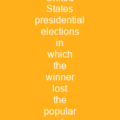The term swing state refers to any state that could reasonably be won by either the Democratic or Republican presidential candidate by a swing in votes. These states are usually targeted by both major-party campaigns, especially in competitive elections. Meanwhile, the states that regularly lean to a single party are known as safe states.
About Swing state in brief

Two electoral votes go to the person who wins a plurality in the state, and a candidate gets one additional electoral vote for each Congressional District in which they receive a plurality. Both of these states have relatively few electoral votes – a total of 4 and 5, respectively. Despite their rules, only twice has each state’split’ its electoral votes – in 2008, when Nebraska gave 4 votes to Republican John McCain, and one to Democrat Barack Obama; and in 2016, when one of Maine’s congressional districts was won by Donald Trump and the other district and the state itself were won by Hillary Clinton. It is far from unheard of for a candidate to secure sufficient electoral votes while not having won the national popular vote. In past electoral results, Republican candidates would have expected to easily win most of the mountain states and Great Plains, such as Idaho, Wyoming, the Dakotas, Montana, Utah, Kansas, Oklahoma, and Nebraska. However, some states that consistently vote for one party at the presidential level occasionally elect a governor of the opposite party. This is currently the case in Massachusetts, Maryland, and Vermont, which all have Republican governors, as well as in Louisiana, Kentucky,Kansas, and Montana, which currently have Democratic governors. Despite the rules, Maine and Nebraska’s 2nd congressional districts are considered to be competitive races in the 2020 Presidential election.
You want to know more about Swing state?
This page is based on the article Swing state published in Wikipedia (as of Nov. 30, 2020) and was automatically summarized using artificial intelligence.







